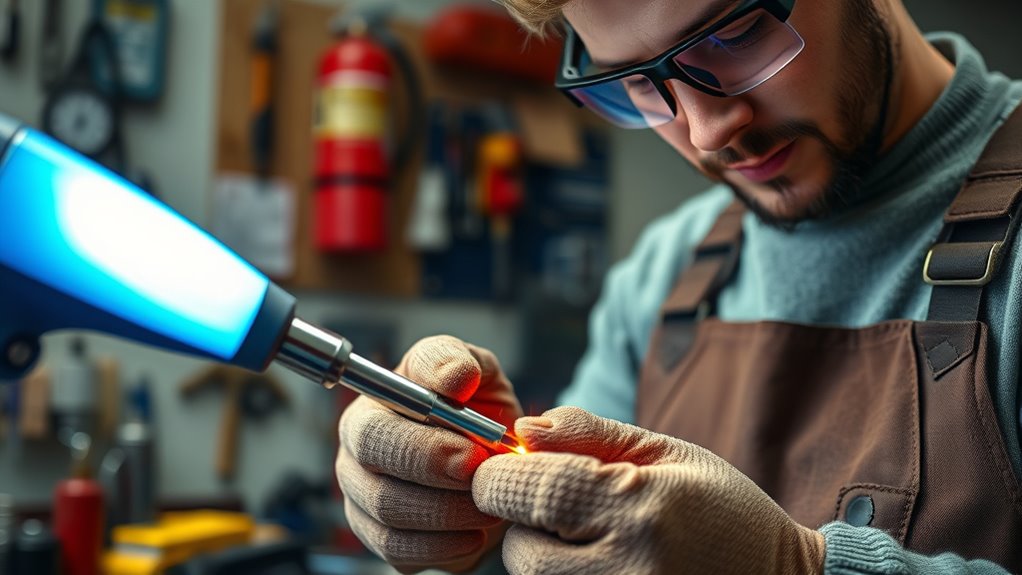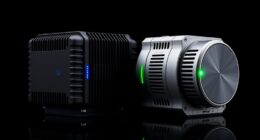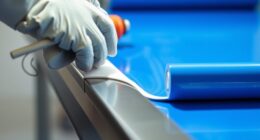To guarantee safety with irons and heat guns, always wear heat-resistant gloves and safety glasses to protect yourself from burns and sparks. Familiarize yourself with the device’s controls, and inspect cords and the appliance regularly for damage. Use proper techniques, such as keeping the tool in motion and setting the right temperature. Always unplug and let the tool cool before storing. Continuing to learn the best safety practices can help you avoid accidents every time you use these heat tools.
Key Takeaways
- Always wear heat resistant gloves and safety glasses during use and adjustments.
- Regularly inspect tools for damage, frayed cords, or scorch marks before operating.
- Set proper temperature levels and test on scrap material prior to use.
- Keep the tools in motion and place on heat-resistant surfaces when not in use.
- Unplug immediately if overheating, and keep a fire extinguisher nearby for emergencies.
Understanding the Proper Handling of Heat Tools

To handle heat tools safely, you need to understand how to operate them correctly. Always use heat resistant gloves to protect your hands from burns, especially when adjusting or moving hot tools. Familiarize yourself with the temperature controls on your device; setting the right temperature prevents overheating and reduces accident risks. Before turning on the tool, read the manufacturer’s instructions carefully. Keep the appliance steady and avoid rushing, as sudden movements can cause accidents. Check the cord and plug for damage before use. When you’re finished, turn off the heat tool and allow it to cool completely before storing. Proper handling ensures your safety and extends the lifespan of your equipment. Additionally, understanding the proper handling of heat tools can help prevent damage to your equipment and ensure safe usage.
Essential Safety Gear and Precautions

Wearing the right safety gear is essential whenever you work with heat tools. Protect your hands with heat resistant gloves to prevent burns from accidental contact or hot surfaces. These gloves shield you from high temperatures and provide better grip, reducing slips. Safety glasses are equally important—they safeguard your eyes from sparks, debris, or accidental splashes of hot materials. Always wear your safety glasses before turning on your heat tool, even if you’re experienced. Keep your safety gear in good condition and don’t skip wearing it, as minor lapses can lead to serious injuries. Remember, safety gear isn’t just a precaution; it’s a crucial part of your protective routine, helping you work confidently and avoid preventable accidents. Proper safety measures, such as protective gear, are vital for ensuring safe operation and reducing the risk of injuries.
Maintenance and Inspection for Safe Operation

Regular maintenance and thorough inspections are essential for guaranteeing your heat tools operate safely and effectively. Over time, thermal degradation can weaken internal components, increasing the risk of malfunctions or hazards. Inspect your iron or heat gun regularly for signs of wear, such as frayed cords, damaged plugs, or scorch marks. Ensure that vents are clear to prevent overheating. Maintaining electrical safety involves checking for exposed wiring or loose connections that could cause short circuits or shocks. Clean the heating element and exterior surfaces to prevent buildup that might interfere with performance. If you notice any damage or irregularities, stop using the tool immediately and have it repaired by a qualified technician. Proper maintenance reduces risks and extends the lifespan of your heat tools.
Safe Usage Techniques for Irons and Heat Guns

Using heat tools safely requires paying close attention to proper handling and operation techniques. Always wear heat resistant gloves to protect your hands from accidental contact with hot surfaces. Maintain good control by keeping a firm grip on the tool and avoiding distractions. Proper temperature regulation is essential; set the heat to the appropriate level for your task to prevent damage or mishaps. Before starting, test the temperature on a scrap piece or inconspicuous area. Keep the tool in motion, avoiding prolonged contact in one spot. When not in use, place the tool on a heat-resistant surface or stand. Regularly check the tool’s cord and plug for damage. Following these techniques minimizes risks and ensures safe, efficient use of your heat tools. Incorporating sound vibrations into your routine can further promote relaxation and safety during your crafting sessions.
Emergency Procedures and Accident Prevention

To prevent accidents when working with heat tools, it’s crucial to know the proper emergency procedures. First, always unplug the device immediately if you notice a fire hazard or if it overheats. Keep a fire extinguisher nearby, and know how to use it properly in case of an electrical safety emergency. If your heat tool causes a fire, don’t try to put it out with water—use a fire extinguisher suitable for electrical fires. In case of electric shock, disconnect the tool from power and seek medical attention if needed. Never leave heat tools unattended while hot. Regularly inspect cords and plugs for damage to prevent electrical safety issues. Using proper placement can help prevent overheating and accidents. Quick, calm action minimizes injury and damage, keeping you safe while working with heat.
Frequently Asked Questions
Can Heat Tools Be Used Around Children Safely?
You should never use heat tools around children without proper precautions. Always implement childproofing tips like keeping tools out of their reach and unplugging them immediately after use. Follow heat safety precautions by never leaving a heat tool unattended near children and ensuring it’s cool before storing. Supervise children closely if they’re nearby, and educate them on the dangers of heat tools to prevent accidents.
What Is the Recommended Storage Method for Heat Tools?
A place for everything, and everything in its place—this applies perfectly to storing heat tools. You should store them in a cool, dry location, ideally in a designated case or container to guarantee proper organization. Always unplug and let them cool completely before storage. Keep cords untangled and out of reach of children. Proper storage safety minimizes accidents and prolongs your tools’ lifespan, making your workspace safer and more efficient.
How Often Should Heat Tools Be Professionally Inspected?
You should have your heat tools professionally inspected at least once a year to guarantee they meet safety standards. Regular inspections help identify potential issues like damaged cords or faulty heating elements before they become hazards. By adhering to a routine professional inspection schedule, you minimize risks and maintain safe operation, keeping you and others protected during use. Always follow manufacturer recommendations and safety standards for maximum safety.
Are There Specific Fabrics or Materials to Avoid With Heat Tools?
Did you know certain fabrics are more prone to damage from heat? You should avoid heat tools on delicate materials like polyester, nylon, and acetate, as they have specific fabric restrictions that can cause melting or scorching. Be cautious with synthetic fabrics, as they pose material hazards when exposed to high temperatures. Always check the manufacturer’s instructions and test on a small area first to prevent unintended damage.
What Are Signs of Damage Indicating a Heat Tool Needs Replacement?
You should replace your heat tool when you notice damage indicators like frayed cords, scorch marks, or inconsistent heat output. Regular heat tool maintenance helps spot these issues early. When you see melted or burned plastic, unusual noises, or if the tool doesn’t heat evenly, it’s time for a replacement. Ignoring damage indicators can lead to safety hazards, so always prioritize replacing your heat tool when signs of damage appear.
Conclusion
By understanding how to handle heat tools safely, wearing the right safety gear, maintaining your equipment, practicing proper techniques, and knowing emergency procedures, you protect yourself and others. Stay alert, stay cautious, and stay prepared—because safety isn’t just a step, it’s a habit. Keep safety in mind, keep safety in action, and keep safety your priority. With these tips, you’ll work confidently, efficiently, and accident-free every time.









